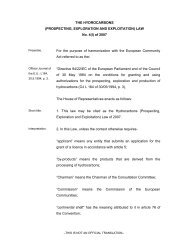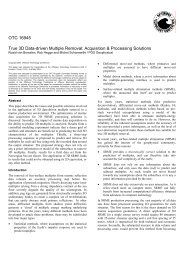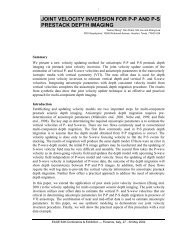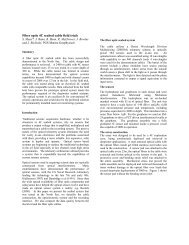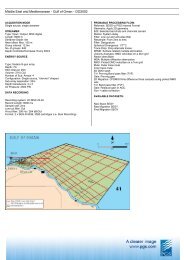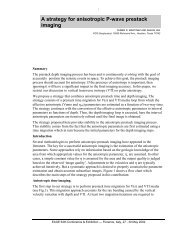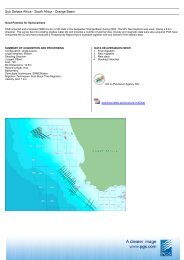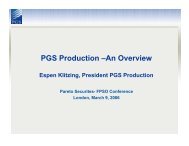Annual Report 2011 - PGS
Annual Report 2011 - PGS
Annual Report 2011 - PGS
You also want an ePaper? Increase the reach of your titles
YUMPU automatically turns print PDFs into web optimized ePapers that Google loves.
Notes to the consolidated financial statements<br />
NOTES TO THE CONSOLIDATED FINANCIAL STATEMENTS<br />
Note 2 - Summary of Significant Accounting Policies<br />
Adoption of new and revised policies and standards and interpretations<br />
The new standards, amendments and interpretations effective for the year ended 31 December <strong>2011</strong> have not been applied in<br />
preparing these consolidated financial statements as they did not have any significant impact.<br />
Significant changes to accounting policies<br />
From January 1, <strong>2011</strong> the Company changed the policy for recognition of costs incurred in connection with major overhaul of<br />
vessels. Under the new policy the directly attributable costs incurred in connection with major overhaul are capitalized and<br />
depreciated over the estimated period till the next similar overhaul. The former policy was to expense such costs when incurred.<br />
The change is made to better reflect the economic reality, reduce volatility and align the accounting to industry practice and<br />
practice among other vessel owning companies. The change in policy is applied for all reported periods, including periods prior<br />
to January 1, <strong>2011</strong>. See note 36 for presentation of adjustments made in the restated periods.<br />
Consolidation<br />
Subsidiaries and business combinations<br />
Subsidiaries are all entities (including special purpose entities) over which the Company has the power to govern the financial<br />
and operating policies generally accompanying a shareholding of more than one half of the voting rights. The existence and<br />
effect of potential voting rights that are currently exercisable or convertible are considered when assessing whether the<br />
Company controls another entity.<br />
Subsidiaries are consolidated in the financial statements from the point in time when the Company gains control. The acquisition<br />
of subsidiaries is accounted for using the acquisition method of accounting. Acquisition cost is assigned to the assets and<br />
liabilities of the subsidiaries, including previously unrecognized intangible assets and contingent liabilities, using their fair value<br />
at the date of acquisition. Any excess of purchase cost over fair value of assets and liabilities is recorded as goodwill. Following<br />
initial recognition, goodwill is not amortized, but measured at cost less any accumulated impairment losses. All inter-company<br />
transactions and balances have been eliminated in the consolidation. In those cases where the subsidiaries are not wholly<br />
owned, the non-controlling interests are presented separately in the consolidated statements of operations and consolidated<br />
statements of financial position.<br />
Investments in joint ventures<br />
A joint venture is a contractual arrangement whereby the Company undertakes an economic activity that is subject to joint<br />
control under which strategic financial and operating policy decisions relating to the activities require the unanimous consent of<br />
the parties sharing control.<br />
The Company reports its interests in jointly controlled entities using the equity method of accounting. Under the equity method,<br />
investments in joint ventures are carried in the consolidated statements of financial position at cost as adjusted for postacquisition<br />
changes in the Company’s share of the net assets of the joint venture (i.e. profit or loss and equity adjustments), less<br />
any impairment in the value of individual investments. Losses of a joint venture in excess of the Company’s interest in that joint<br />
venture (which includes any long-term interests that, in substance, form part of the Company’s net investment in the joint<br />
venture) are not recognized, unless the Company has incurred legal or constructive obligations or made payments on behalf of<br />
the joint venture. Profits and losses resulting from transactions between the Company and the joint venture are eliminated to the<br />
extent of the interest in the joint venture.<br />
When the Company contributes or sells assets to the joint venture, any portion of gain or loss from the transaction is recognised<br />
based on the substance of the transaction and any gain or loss of such transactions are eliminated to the extent of the<br />
Company’s interest in the joint venture. When the Company purchases assets from the joint venture, the Company does not<br />
recognise its share of the profits of the joint venture from the transaction until it resells the assets to an independent party.<br />
The Company periodically reviews its net investments in joint ventures to determine whether there is any indication of<br />
impairment loss. If any such indication exists, the recoverable amount of the joint venture is estimated in order to determine the<br />
extent of the impairment loss (if any).<br />
Investments in associated companies<br />
An associated company is an entity over which the Company has significant influence and that is neither a subsidiary nor an<br />
interest in a joint venture. Significant influence is the power to participate in the financial and operating policy decisions of the<br />
investee but is not control or joint control over those policies, generally accompanying a shareholding of between 20% and 50%<br />
of the voting rights.<br />
The net results and assets and liabilities of associated companies are incorporated in these financial statements using the<br />
equity method of accounting, except when the investment is classified as held-for-sale (see below).<br />
The Company periodically reviews its investments in associated companies to determine whether there is any indication of an<br />
impairment loss. If such indication exists, the recoverable amount of the associate is estimated in order to determine the extent<br />
of the impairment loss (if any).<br />
Held-for-sale and discontinued operations<br />
Results of subsidiaries or operations disposed of during the financial year are included in the Company’s profit up to the<br />
effective date of disposal. When the Company intends to dispose of, or classify as held-for-sale, a business component that<br />
3 <strong>PGS</strong> ANNUAL REPORT <strong>2011</strong><br />
74 <strong>PGS</strong> <strong>Annual</strong> <strong>Report</strong> <strong>2011</strong>



